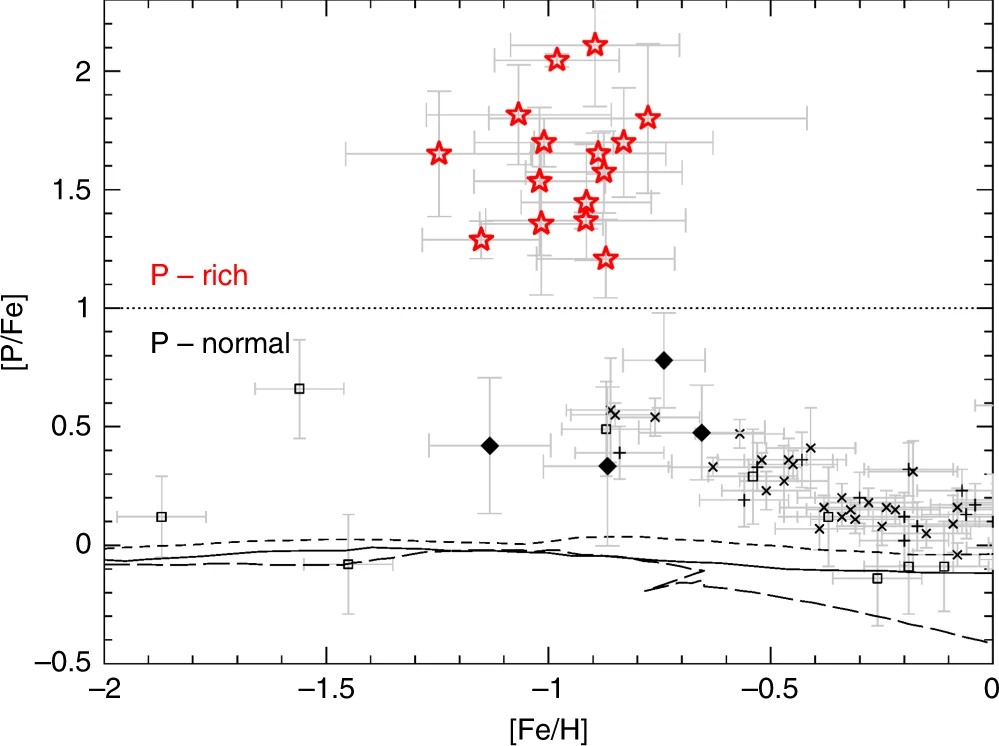Phosphorus-rich stars and the seeds of life
Phosphorus is an essential element for life. Along with hydrogen, carbon, nitrogen, oxygen and calcium, they make almost 99 percent of our body mass. Its name comes from the ancient Greek - as it is common in science - “Φώσφορος” meaning “light-bearer” (or in latin Lucifer), and it was referred to planet Venus. What does a planet have in common with an element you might ask; the answer lies in the faint glow that both objects have. In the case of the element phosphorus, the glow is caused from reaction with oxygen.
We can get it from our diet; some phosphorus rich foods include pumpkin seeds, cottage cheese and sardines. Compounds of phosphorus called phosfites can be found in fertilizers and in the first season of the popular AMC’s “Breaking Bad” series, Walter White (a.k.a. Heisenberg) killed couple of his enemies using phosphine gas, a poisonous gas made from red phosphorus, moisture and heat.
Moving beyond pop culture references, what makes this element so important is that phosphates are also the main ingredient of our DNA and RNA molecules, which carry our genetic code (the instructions on how to build proteins, how to function, how to reproduce etc.)
Where can we find it?
Even though it has such an important role for life, phosphorus is relatively scarce in the universe. Comparing to the other five most abundant elements in our body, phosphorus ranks only 14th out of the 92 natural occurring elements in our solar system, while hydrogen is 1st, oxygen is 3rd, carbon is 4th, and calcium is 9th. That raises a couple of questions; how is this element produced in the universe and how it reached our planet.
Our current understanding about the origin of phosphorus includes violent space explosions. Most of the phosphorus is thought to be produced in supernovae explosions, the swan song of a massive star’s life. Another possible scenario is classical novae explosions, which involve a cosmic dance between a white dwarf star - a stellar corpse, the last stage of evolution for our own Sun - and a regular star. The white dwarf steals material from its dance companion due to gravity and when temperature rises to a critical limit, an explosion happens. Nevertheless, state-of-the art models that calculate the evolution of chemical elements in the Galaxy over time predict less phosphorus compared to what is found in stars and meteorites.
Finding phosphorus-rich stars
Recently, researchers from the Instituto de Astrofísica de Canarias (IAC) discovered 15 stars in the Galaxy with an unusually high phosphorus abundance. For their work, they used a large number of infrared spectra - this is light that our eyes are not sensitive to, but we use it widely, such as in thermal imaging. For another pop culture reference, remember Pink Floyd’s “Dark Side of the Moon” cover, it’s the light beyond the red color! - emitted by stars from the Sloan Digital Sky Survey (SDSS). One of the great successes of twentieth century astronomy is that we understood how we can tell what a star is made of, just by collecting the light it emits!

In addition to the high phosphorus abundance, these peculiar stars contained more oxygen, magnesium, silicon, aluminum and even cerium compared to similar stars. Due to these extraordinary results, the researchers set off on a detective-type mission to discover the origin of these stars.
These results show that not only are we dealing with a new type of objects, but that their discovery opens the way for the exploration of new physical mechanisms and nuclear reactions which occur in stellar interiors.
-Thomas Masseron (IAC)
Using state-of-the-art computer simulations, they tested different scenarios, such as supernovae and novae explosions, hoping to match the abundance pattern of the phosphorus-rich stars. They ruled out many possibilities, but they couldn’t reach on a final verdict even though it seemed that massive stars are the most likely suspect.
A discovery which is so unexpected and extraordinary could not have been made without a close interdisciplinary collaboration between astronomers and experts in computation.
-Arturo Manchado (IAC)
Is the mystery solved?
In a follow-up study few months ago, some further light was shed in the origin of these peculiar stars. The researchers returned to the crime scene and obtained high-resolution data from two phosphorus-rich stars, including a new one, which allowed them to get detailed stellar abundances of more elements compared to the previous study. Using similar techniques, they concluded that the results are consistent with a distinct nucleosynthesis scenario, called the s-process (or slow neutron capture process), which is thought to occur in red giant stars. To complicate things further, this conclusion cannot explain the richness in light elements, such as oxygen, magnesium and silicon. For this reason, the researchers argue that they discovered the fingerprint of a new kind of s-process nucleosynthesis that has never been seen before and it could help us better understand the nature of the phosphorus-rich stars and their role in the chemical evolution of the Galaxy.
What should we expect for the future?
The future looks definitely bright (pun intended!) for the search of more phosphorus-rich stars. New space telescopes, such as the James Webb Space Telescope (JWST) which is expected to be launched later this year, will help us expand our knowlegde about these stars and get us one step closer into understanding the origin of DNA on Earth.
T. Masseron et al., Nat. Commun, 11, 3759 (2020)